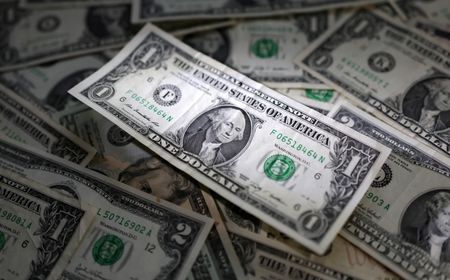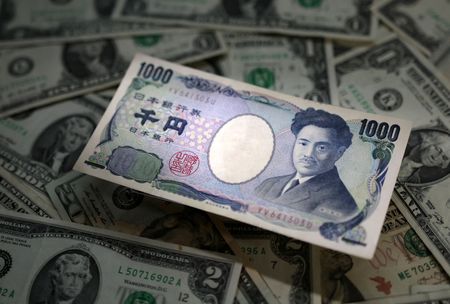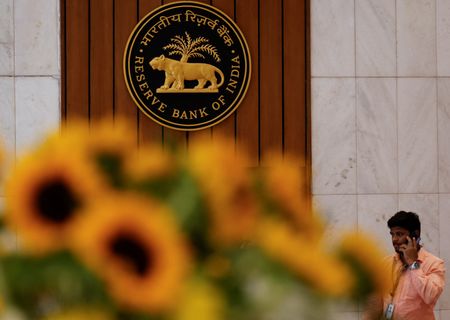By Gertrude Chavez-Dreyfuss
NEW YORK (Reuters) – The U.S. dollar rose against a broad range of currencies on Friday including the euro, sterling and those tied to commodities such as the Australian dollar, as investors consolidated positions ahead of the weekend, looked to more inflation data next week and kept an eye on tariff headlines.
“The greenback is undergoing a technical rebound after suffering a sustained selloff in recent weeks, and other currencies are also seeing risk discounts come back as trade worries return,” said Karl Schamotta, chief market strategist, at Corpay in Toronto.
The dollar, however, pared gains after S&P Global data on Friday showing U.S. business activity dropped to a 17-month low this month. It fell again after declines seen in the University of Michigan sentiment report and U.S. existing home sales data.
The reports kept the prospect of interest rate cuts by the Federal Reserve intact this year, even though the Fed will remain on hold for the next several months.
U.S. rate futures on Friday priced in 44 basis points (bps) of easing this year, compared with 38 bps on Thursday, according to LSEG calculations. The Fed could likely resume cutting interest rates again either at the September or October policy meeting, LSEG data showed.
Markets will next look to the Personal Consumption Expenditures (PCE) index, the Fed’s preferred inflation measure, due for release a week from now for more confirmation of the central bank’s rate path.
In afternoon trading, the euro stumbled against the dollar after a series of business activity surveys showed a sharp contraction in early February in France and only mild improvement in Germany – the euro zone’s traditional twin engines of growth.
It was last down 0.4% at $1.0461, on track for its largest daily fall since early February.
Investors are also looking at Sunday’s election in Germany, where polls point to a conservative coalition win that could be pivotal in shaping their expectations for future economic growth.
The dollar was also up against the commodity currencies: the Australian, New Zealand and Canadian dollars, but was slightly lower versus the Swiss franc at 0.8972.
Against the yen, however, the dollar dropped 0.4% to 149.02 after earlier hitting a new 11-week low of 148.93. The U.S. currency has fallen in five of the past six weeks, and was down 2.2% on the week.
The yen rallied as a selloff in Japanese government bonds drove yields to 2009 highs after national core inflation hit a 19-month peak in January. That fueled expectations of more rate hikes in Japan.
Bank of Japan (BOJ) chief Kazuo Ueda quickly doused the momentum, saying the central bank could contain long-term interest rates by buying government bonds.
The yen has gained about 3.9% against the dollar so far in February. Another quarter-basis point rate hike is not fully priced in until September, although interest rate markets have factored in a slight chance of a hike as soon as May.
WEAK US DATA
In the United States, data showing the S&P Global’s flash U.S. Composite PMI Output Index falling to 50.4 this month, compared with 52.7 in January, pulled the dollar lower against the yen. This month’s reading was the lowest since September 2023, with the PMI index tracking both the manufacturing and services sectors.
The dollar also gave up some of its gains after a more-than-expected drop in the U.S. consumer sentiment index to a 15-month low. Inflation expectations, however, surged as households worried about President Donald Trump’s steep and broad-based tariffs and their impact on their purchasing power.
U.S. existing home sales also came in softer than expected, down 4.9% last month.
Overall, the dollar has been struggling for traction in the past few weeks. The index has fallen 1.7% in February, heading for its biggest monthly slide since August.
The dollar index was last up 0.2% at 106.59.
On the trade front, Trump unveiled this week plans for tariffs on lumber imports, but also said a new trade deal with China was possible.
“If Donald Trump primarily sees tariffs as a way to plug gaps in the U.S. fiscal outlook, as some are now reporting, trading partners like Canada, Mexico and the euro area could find themselves unable to negotiate their way out of the next round of trade duties, raising the risk of downside moves in currency markets,” Corpay’s Schamotta said.
The pound, meanwhile, fell 0.3% to $1.2631, weighed down by the dollar’s overall strength. It did gain earlier after data showing UK retail sales rose more than expected in January. A separate survey showed UK business activity expanded in February, although employers made deep cuts to staffing levels.
Currency
bid
prices
at 21
February
07:45
p.m. GMT
Descript RIC Last U.S. Pct YTD High Low
ion Close Chang Pct Bid Bid
Previous e
Session
Dollar 106.59 106.35 0.24% -1.75% 106.74 106
index .35
Euro/Dol 1.0462 1.0502 -0.38 1.06% $1.050 $1.
lar % 6 044
9
Dollar/Y 149.02 149.63 -0.37 -5.26% 150.71 148
en % .97
Euro/Yen 155.92 157.14 -0.78 -4.47% 158.22 155
% .82
Dollar/S 0.8971 0.898 -0.09 -1.14% 0.9005 0.8
wiss % 968
Sterling 1.2629 1.2668 -0.29 0.99% $1.267 $1.
/Dollar % 9 262
6
Dollar/C 1.423 1.4169 0.46% -1.02% 1.4234 1.4
anadian 169
Aussie/D 0.6352 0.6402 -0.74 2.69% $0.640 $0.
ollar % 9 635
2
Euro/Swi 0.9384 0.9429 -0.48 -0.1% 0.9435 0.9
ss % 381
Euro/Ste 0.8281 0.8288 -0.08 0.1% 0.8292 0.8
rling % 265
NZ 0.5735 0.5763 -0.45 2.53% $0.577 0.5
Dollar/D % 2 737
ollar
Dollar/N 11.1423 11.0867 0.5% -1.97% 11.144 11.
orway 5 084
7
Euro/Nor 11.6563 11.644 0.13% -0.96% 11.666 11.
way 617
8
Dollar/S 10.6502 10.625 0.24% -3.33% 10.659 10.
weden 8 618
4
Euro/Swe 11.144 11.1587 -0.13 -2.82% 11.168 11.
den % 5 118
(Reporting by Gertrude Chavez-Dreyfuss; Additional reporting by Amanda Cooper in London, Tom Westbrook in Singapore and Brigid Riley in Tokyo; Editing by Jamie Freed, Kim Coghill, Helen Popper, Giles Elgood, Will Dunham and Deepa Babington)











